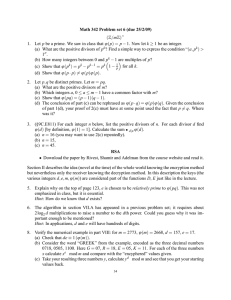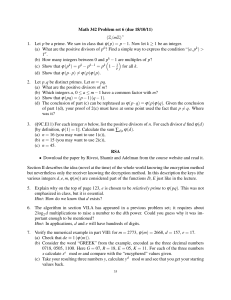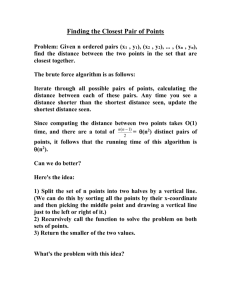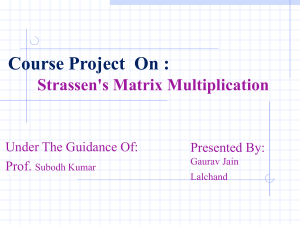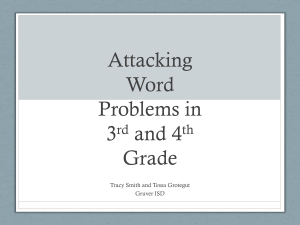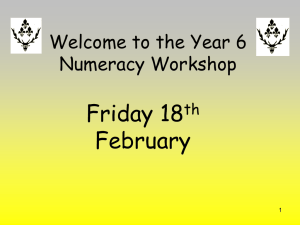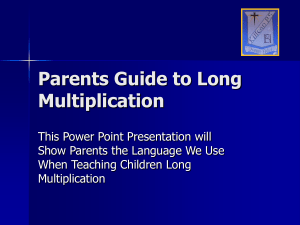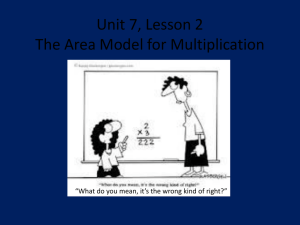Powerpoint slides
advertisement
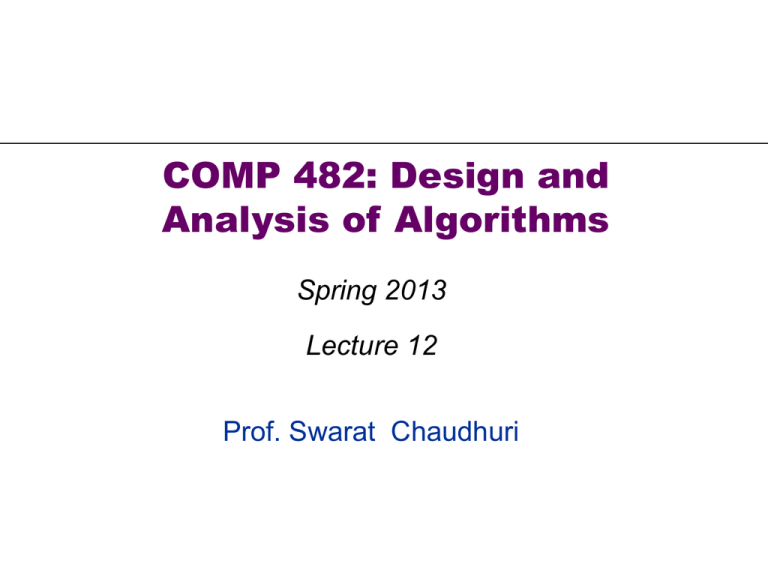
COMP 482: Design and
Analysis of Algorithms
Spring 2013
Lecture 12
Prof. Swarat Chaudhuri
5.4 Closest Pair of Points
Closest Pair of Points
Algorithm.
Divide: draw vertical line L so that roughly ½n points on each side.
Conquer: find closest pair in each side recursively.
Combine: find closest pair with one point in each side.
Return best of 3 solutions.
L
8
21
12
3
Closest Pair Algorithm
Closest-Pair(p1, …, pn) {
Compute separation line L such that half the points
are on one side and half on the other side.
1 = Closest-Pair(left half)
2 = Closest-Pair(right half)
= min(1, 2)
O(n log n)
2T(n / 2)
Delete all points further than from separation line L
O(n)
Sort remaining points by y-coordinate.
O(n log n)
Scan points in y-order and compare distance between
each point and next 11 neighbors. If any of these
distances is less than , update .
O(n)
return .
}
4
Closest Pair of Points: Analysis
Running time.
T(n) £ 2T ( n/2) + O(n log n) Þ T(n) = O(n log2 n)
Q. Can we achieve O(n log n)?
A. Yes. Don't sort points in strip from scratch each time.
Each recursive returns two lists: all points sorted by y coordinate,
and all points sorted by x coordinate.
Sort by merging two pre-sorted lists.
T(n) £ 2T ( n/2) + O(n) Þ T(n) = O(n log n)
5
Q1: Significant inversions
Let’s “relax” the inversion-counting problem a bit. Call a pair of numbers
ai, aj a significant inversion if i < j and ai > 2aj. Give an O(n log n)
algorithm to count the number of significant inversions between two
orderings.
6
Counting Inversions
Pre-condition. [Merge-and-Count] A and B are sorted.
Post-condition. [Sort-and-Count] L is sorted.
Sort-and-Count(L) {
if list L has one element
return 0 and the list L
Divide the list into two halves A and B
(rA, A) Sort-and-Count(A)
(rB, B) Sort-and-Count(B)
(rB, L) Merge-and-Count(A, B)
}
return r = rA + rB + r and the sorted list L
7
Answer (partial)
The algorithm is similar to the one for counting inversions.
The difference is that in the “conquer” step we merge twice:
•
First merge A and B just for sorting
•
Then merge A and B’ where for all i, B’[i] = 2 B[i], with the goal of
counting significant inversions.
8
5.5 Integer Multiplication
Integer Arithmetic
Add. Given two n-digit integers a and b, compute a + b.
O(n) bit operations.
Multiply. Given two n-digit integers a and b, compute a × b.
Brute force solution: (n2) bit operations.
1 1 0 1 0 1 0 1
* 0 1 1 1 1 1 0 1
1 1 0 1 0 1 0 1 0
Multiply
0 0 0 0 0 0 0 0 0
1 1 0 1 0 1 0 1 0
1 1 0 1 0 1 0 1 0
1
1
1
1
1
1
0
1
1
1
0
1
0
1
0
1
+
0
1
1
1
1
1
0
1
1
0
1
0
1
0
0
1
0
Add
1 1 0 1 0 1 0 1 0
1 1 0 1 0 1 0 1 0
1 1 0 1 0 1 0 1 0
0 0 0 0 0 0 0 0 0
0 1 1 0 1 0 0 0 0 0 0 0 0 0 0 1 0
10
Divide-and-Conquer Multiplication: Warmup
To multiply two n-digit integers:
Multiply four ½n-digit integers.
Add two ½n-digit integers, and shift to obtain result.
x
= 2 n / 2 × x1 + x0
y
= 2 n / 2 × y1 + y0
xy =
(2
n/2
× x1 + x0
) (2
n/2
)
× y1 + y0 = 2 n × x1 y1 + 2 n / 2 × ( x1 y0 + x0 y1 ) + x0 y0
T(n) = 4T (n /2 ) + Q(n)
recursive calls
Þ T(n) = Q(n 2 )
add, shift
assumes n is a power of 2
11
Karatsuba Multiplication
To multiply two n-digit integers:
Add two ½n digit integers.
Multiply three ½n-digit integers.
Add, subtract, and shift ½n-digit integers to obtain result.
x
= 2 n / 2 × x1 + x0
y
= 2 n / 2 × y1 + y0
xy = 2 n × x1 y1 + 2 n / 2 × ( x1 y0 + x0 y1 ) + x0 y0
= 2 n × x1 y1 + 2 n / 2 × ( (x1 + x0 ) (y1 + y0 ) - x1 y1 - x0 y0 ) + x0 y0
A
B
A
C
C
Theorem. [Karatsuba-Ofman, 1962] Can multiply two n-digit integers
in O(n1.585) bit operations.
T(n) £ T ( ën /2û ) + T ( én /2ù ) + T ( 1+ én /2ù ) +
recursive calls
Þ T(n) = O(n
log 2 3
Q(n)
add, subtract, shift
) = O(n1.585 )
12
Karatsuba: Recursion Tree
ì
0
if n = 1
T(n) = í
î 3T(n /2) + n otherwise
log 2 n
T(n) = å n
k=0
()
3 k
2
( 23)
1+ log 2 n
=
3 -1
2
-1
= 3nlog2 3 - 2
n
T(n)
T(n/2)
T(n/2)
T(n/2)
3(n/2)
T(n/4) T(n/4) T(n/4)
T(n/4) T(n/4) T(n/4)
T(n/4) T(n/4) T(n/4)
9(n/4)
...
...
3k (n / 2k)
T(n / 2k)
...
T(2)
T(2)
T(2)
T(2)
...
T(2)
T(2)
T(2)
T(2)
3 lg n (2)
13
Q2: Two recurrences
Solve the following recurrences:
T(n) = 8 T(n/2) + O(n2)
T(n) = 7 T(n/2) + O(n2)
14
Fast Matrix Multiplication
Matrix Multiplication
Matrix multiplication. Given two n-by-n matrices A and B, compute C = AB.
cij =
n
å a ik bkj
k =1
éc11 c12
ê
êc21 c22
ê
êc
ë n1 cn2
éa11 a12
c1n ù
ú
ê
c2 n ú
a
a22
= ê 21
ú
ê
ú
êa
cnn û
ë n1 an2
éb11 b12
a1n ù
ú
ê
a2n ú
b b
´ ê 21 22
ú
ê
ú
êb b
ann û
ë n1 n 2
b1n ù
ú
b2n ú
ú
bnn úû
Brute force. (n3) arithmetic operations.
Fundamental question. Can we improve upon brute force?
16
Matrix Multiplication: Warmup
Divide-and-conquer.
Divide: partition A and B into ½n-by-½n blocks.
Conquer: multiply 8 ½n-by-½n recursively.
Combine: add appropriate products using 4 matrix additions.
éC11 C12 ù
é A11
ê
ú = ê
C
C
ë 21
ë A21
22 û
A12 ù é B11
ú´ ê
A22 û ë B21
T(n) = 8T ( n /2 ) +
recursive calls
B12 ù
ú
B22 û
Q(n2 )
C11
=
C12
=
C21
=
C22
=
( A11 ´ B11 ) + ( A12 ´ B21 )
( A11 ´ B12 ) + ( A12 ´ B22 )
( A21 ´ B11 ) + ( A22 ´ B21 )
( A21 ´ B12 ) + ( A22 ´ B22 )
Þ T(n) = Q(n 3 )
add, form submatrices
17
Matrix Multiplication: Key Idea
Key idea. multiply 2-by-2 block matrices with only 7 multiplications.
éC11 C12 ù
é A11
ê
ú = ê
ëC21 C22 û
ë A21
C11
C12
C21
C22
=
=
=
=
A12 ù é B11
ú ´ê
A22 û ë B21
B12 ù
ú
B22 û
P5 + P4 - P2 + P6
P1 + P2
P3 + P4
P5 + P1 - P3 - P7
P1
=
A11 ´ ( B12 - B22 )
P2
= ( A11 + A12 ) ´ B22
P3
= ( A21 + A22 ) ´ B11
P4
=
P5
= ( A11 + A22 ) ´ ( B11 + B22 )
P6
P7
= ( A12 - A22 ) ´ ( B21 + B22 )
= ( A11 - A21 ) ´ ( B11 + B12 )
A22 ´ ( B21 - B11 )
7 multiplications.
18 = 10 + 8 additions (or subtractions).
18
Fast Matrix Multiplication
Fast matrix multiplication. (Strassen, 1969)
Divide: partition A and B into ½n-by-½n blocks.
Compute: 14 ½n-by-½n matrices via 10 matrix additions.
Conquer: multiply 7 ½n-by-½n matrices recursively.
Combine: 7 products into 4 terms using 8 matrix additions.
Analysis.
Assume n is a power of 2.
T(n) = # arithmetic operations.
T(n) = 7T (n /2 ) +
recursive calls
Q(n 2 )
Þ T(n) = Q(n log2 7 ) = O(n 2.81 )
add, subtract
19
Fast Matrix Multiplication in Practice
Implementation issues.
Sparsity.
Caching effects.
Numerical stability.
Odd matrix dimensions.
Crossover to classical algorithm around n = 128.
Common misperception: "Strassen is only a theoretical curiosity."
Advanced Computation Group at Apple Computer reports 8x speedup
on G4 Velocity Engine when n ~ 2,500.
Range of instances where it's useful is a subject of controversy.
Remark. Can "Strassenize" Ax=b, determinant, eigenvalues, and other
matrix ops.
20
Fast Matrix Multiplication in Theory
Q. Multiply two 2-by-2 matrices with only 7 scalar multiplications?
A. Yes! [Strassen, 1969]
Q(n log2 7 ) = O(n 2.81 )
Q. Multiply two 2-by-2 matrices with only 6 scalar multiplications?
A. Impossible. [Hopcroft and Kerr, 1971]
Q. Two 3-by-3 matrices with only 21 scalar multiplications?
A. Also impossible.
Q. Two 70-by-70 matrices with only 143,640 scalar multiplications?
A. Yes! [Pan, 1980]
log 70 143640
2.80
Q(n
) = O(n
)
Decimal wars.
December, 1979: O(n2.521813).
January, 1980: O(n2.521801).
21
Fast Matrix Multiplication in Theory
Best known. O(n2.376) [Coppersmith-Winograd, 1987.]
Conjecture. O(n2+) for any > 0.
Caveat. Theoretical improvements to Strassen are progressively less
practical.
22
